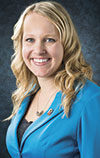“We know that we are never going back to 70 percent or 80 percent of the cattle negotiated on the cash market,” said Greiman. “Why? You are paying extra premiums for calves.”
Feeders trying to fill a yard with repeat suppliers, following special protocols or participating in a verification program need a return on the investment. Cow-calf producers need to get extra for their calves if they’ve spent more on improved genetics and management compared with the average.
“We are trying to market the value of our cattle,” the feeder said. They are no longer all commodities.
The partner in Greiman Brothers farm near Garner, Iowa, drew on his work as chair of the National Cattlemen’s Beef Association (NCBA) cattle marketing committee to talk about price discovery with the feeders, allied industry and academia gathered in Omaha, Nebraska, and Garden City, Kansas.
“Retailers or customers want something specific, and in doing that, we form these alliances and partnerships,” he said, “but we also change the dynamics of our market. I’m not saying that’s bad; it’s where the market is going.”
It does cause challenges in establishing base price.
USDA’s Mandatory Price Reporting came about in the late 1990s as a way to introduce more transparency in the market.
“When it first started, its purpose was to report to us what cattle were trading somewhere else. It was to give us an idea of what people were doing with their cattle in different regions,” Greiman said. “No one ever thought that we would end up pricing cattle off of it.”
But that’s where most grids and formulas draw their starting points.
“When you see the average price in Iowa on 1,000 head traded for 1 dollar and 4 cents, what does that mean? What were those cattle?” he asked. They could be overfat heiferettes or a group with above-average, uniform genetics. “None of us really knows what those cattle are because we can’t see them. We don’t have a picture of them and we weren’t there, so we don’t know what the conditions of those trades are about.
“Another concern I have,” he said, “is what happens when you get to where that last 25 percent of the cattle are actually below average?” That’s not generally the case yet according to the data, he added.
While Greiman used to enter into packer negotiations by asking about premiums, now he first asks, “What am I based off of?”
When fall 2015 brought an all-time low in the number of cattle traded live, down to 15 percent one week, this issue came to the forefront.
“I believe that was the week Texas was less than 500 head,” Greiman said. Price volatility was also high at that time, and packer margins have climbed since then. “There was this bright light shined on the cattle business two years ago.” Since then, elected officials, the Commodity Futures Trading Commission (CFTC), producers and industry stakeholders have been working together to come up with solutions, such as the Fed Cattle Exchange.
“We have a tendency to trade cattle once a week … on Fridays. We were doing a lot of Friday, 4-o’clock and 5-o’clock trades,” he said. The futures corrections come on Mondays. “You see, a market kind of has a tendency to do what it wants to do during the week, because we weren’t telling it anything.”
Cattlemen need to drive changes, Greiman said, because grid marketing works, rewarding the better cattle with better prices, so it’s likely not going away.
A recent conversation with a retailer cemented his thoughts on that. “He’s saying this is what I want. He’s telling the feedlot what we want, and then the feedlot’s going to tell the cow-calf man. The cow-calf man’s going to go to the seedstock producer, and we’re pulling through.
“Well, if you’re going to build a program like that, it’s kind of hard to put them on the open cash market,” Greiman said. ![]()
For more information on the meetings visit the Certified Angus Beef website.
Miranda Reiman is the producer communications director for Certified Angus Beef.
—From Certified Angus Beef news release
PHOTO: Photo courtesy of Certified Angus Beef.











